 The skeletal remains of a soldier unearthed at the Waterloo battlefield in June of 2012 has been identified. He was 23-year-old Friedrich Brandt, a private in the 2nd line battalion of the King’s German Legion, felled by a French musket shot to the chest during the Battle of Waterloo on June 18th, 1815. Although the identification cannot be confirmed with DNA analysis because no descendants are known, the circumstantial evidence makes a strong case.
The skeletal remains of a soldier unearthed at the Waterloo battlefield in June of 2012 has been identified. He was 23-year-old Friedrich Brandt, a private in the 2nd line battalion of the King’s German Legion, felled by a French musket shot to the chest during the Battle of Waterloo on June 18th, 1815. Although the identification cannot be confirmed with DNA analysis because no descendants are known, the circumstantial evidence makes a strong case.
Like a certain other historical figure whose remains were discovered in 2012, Brandt’s skeleton was found underneath a parking lot (an overspill lot for the battlefield visitor’s center). His skull was destroyed by mechanical diggers clearing the area for the planned reconstruction of the visitor’s center, but as soon as the crew realized they’d unearthed human remains they alerted the Ministry of Archaeology for the region of Walloon Brabant and archaeologists excavated the rest of the skeleton which was virtually intact, missing only a foot and some hand bones. They found the deceased also had something else in common with the other personage found under a parking lot: a spinal curvature that would have rendered him unfit for battle by modern standards. He was slight at just 5’1″ tall.
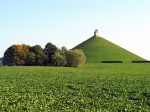 The young man had been hastily buried under 15 inches of soil, probably by his comrades who carried his moribund or dead body 109 yards behind the British front line in the shadow of what is today Lion Mount — a monument built in 1820 on the site where the Prince of Orange was wounded constructed out of 390,000 cubic yards of earth removed from the battlefield — but which in 1815 was the escarpment at the center of Wellington’s line. Victor Hugo describes the altered terrain poetically in Volume 2, Chapter 7 of Les Misérables:
The young man had been hastily buried under 15 inches of soil, probably by his comrades who carried his moribund or dead body 109 yards behind the British front line in the shadow of what is today Lion Mount — a monument built in 1820 on the site where the Prince of Orange was wounded constructed out of 390,000 cubic yards of earth removed from the battlefield — but which in 1815 was the escarpment at the center of Wellington’s line. Victor Hugo describes the altered terrain poetically in Volume 2, Chapter 7 of Les Misérables:
Where the great pyramid of earth, surmounted by the lion, rises to-day, there was a hillock which descended in an easy slope towards the Nivelles road, but which was almost an escarpment on the side of the highway to Genappe. The elevation of this escarpment can still be measured by the height of the two knolls of the two great sepulchres which enclose the road from Genappe to Brussels: one, the English tomb, is on the left; the other, the German tomb, is on the right. There is no French tomb. The whole of that plain is a sepulchre for France.
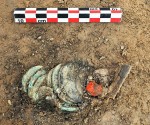 Found with the soldier’s remains were 20 coins, an iron spoon, an unidentified wooden object with the initials “CB” and the date 1792 carved into it, the remains of the leather epaulets from his uniform, a flint and a small red sphere that nobody seems interested in explaining but we were all pretty curious about when it was discovered three years ago. The coins were corroded and only a half franc from 1811 could immediately be identified. Once cleaned, the coins were found to be German and French amounting to a month’s wages for a private in the King’s German Legion.
Found with the soldier’s remains were 20 coins, an iron spoon, an unidentified wooden object with the initials “CB” and the date 1792 carved into it, the remains of the leather epaulets from his uniform, a flint and a small red sphere that nobody seems interested in explaining but we were all pretty curious about when it was discovered three years ago. The coins were corroded and only a half franc from 1811 could immediately be identified. Once cleaned, the coins were found to be German and French amounting to a month’s wages for a private in the King’s German Legion.
Researchers were hoping the epaulets might help identify which regiment the soldier had belonged to, but alas that came to naught. The only additional piece of evidence they were able to find was on the wooden object with the initials. Additional tests performed this February revealed that there was another initial before the CB, an F.
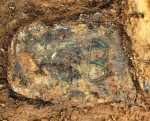 The discovery of the first initial was the breakthrough Gareth Glover, military historian, former Royal Navy officer and treasurer of the Waterloo Association, needed. KGL troops been positioned close to the area where the remains were found. When he checked the KGL muster rolls, he found only three soldiers with the initial FB. One had survived the battle. One died in the hospital in August of 1815. One was Friedrich Brand.
The discovery of the first initial was the breakthrough Gareth Glover, military historian, former Royal Navy officer and treasurer of the Waterloo Association, needed. KGL troops been positioned close to the area where the remains were found. When he checked the KGL muster rolls, he found only three soldiers with the initial FB. One had survived the battle. One died in the hospital in August of 1815. One was Friedrich Brand.
The King’s German Legion was formed after Napoleon conquered Hanover in 1803 and disbanded its army. King George III of England was also Prince-Elector of Hanover, so when his soldiers fled the French occupation, he welcomed them in England. KGL infantry, when they weren’t fighting the French mainly in Spain and Portugal, were quartered in barracks at Bexhill-on-Sea from 1804 until Napoleon’s first abdication in April 1814. Bexhill was a small village of about 100 houses with a population of 2,000. The arrival of 5,000-6,000 troops was initially jarring to the locals who compared them to Cossacks, but they soon settled in and became valued members of the community.
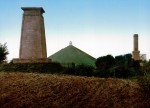 In August of 1814 the 5,000 KGL troops in Bexhill were ordered to return to the continent, much to the dismay of the Bexhillians who had come to love their German friends who sang so beautifully at St. Peter’s church, spent their wages so generously in the shops and hostelries and married their daughters. When Napoleon returned from exile on Elba and took his final stand at Waterloo, the KGL played a key role in the Allied victory, valiantly defending the farm of La Haye Sante 200 yards in front of the center of the
In August of 1814 the 5,000 KGL troops in Bexhill were ordered to return to the continent, much to the dismay of the Bexhillians who had come to love their German friends who sang so beautifully at St. Peter’s church, spent their wages so generously in the shops and hostelries and married their daughters. When Napoleon returned from exile on Elba and took his final stand at Waterloo, the KGL played a key role in the Allied victory, valiantly defending the farm of La Haye Sante 200 yards in front of the center of the
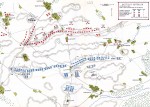 Allied line from late morning until they ran out of ammunition around 6:00 PM. Out of 360 KGL troops holding La Haye Sante, only 39 survived the French onslaught.
Allied line from late morning until they ran out of ammunition around 6:00 PM. Out of 360 KGL troops holding La Haye Sante, only 39 survived the French onslaught.
The rest of the King’s German Legion fought on Wellington’s right flank between Merbe Braine and Hougoumont farm. Private Brandt was part of this group. Glover believes he was slain in the early afternoon between 1:00 and 4:00 PM before his battalion advanced on Hougoumont.
Mr Glover said: “No-one can be 100% sure that the skeleton is Friedrich Brandt but with the information we have, this candidate is by far the most likely.”
 It’s amazing they got anywhere near so educated a guess. Brandt’s is the only complete skeleton recovered from the Waterloo battlefield in two centuries. Close to 50,000 people died in that battle, but the Allied victors claimed their dead and buried them in consecrated ground while the French were burned or buried in mass graves. The graves were picked clean in the 1830s and 40s, the bones ground up to make valuable fertilizer for farmers and the teeth harvested for dentures that became known by the macabre moniker of “Waterloo teeth.”
It’s amazing they got anywhere near so educated a guess. Brandt’s is the only complete skeleton recovered from the Waterloo battlefield in two centuries. Close to 50,000 people died in that battle, but the Allied victors claimed their dead and buried them in consecrated ground while the French were burned or buried in mass graves. The graves were picked clean in the 1830s and 40s, the bones ground up to make valuable fertilizer for farmers and the teeth harvested for dentures that became known by the macabre moniker of “Waterloo teeth.”
To commemorate the bicentennial of the Battle of Waterloo this summer, Belgium is planning a number of special events and exhibitions. The skeleton will be part of an exhibition that opens in May at the Waterloo Battlefield museum, after which I hope he is buried with all due honors.